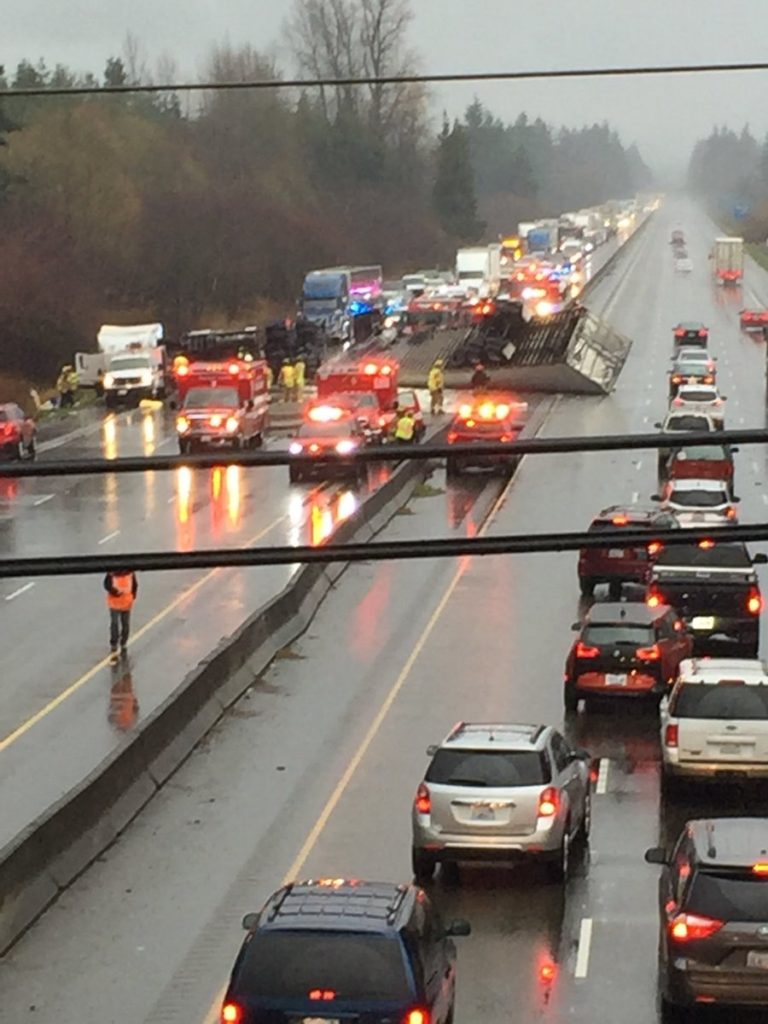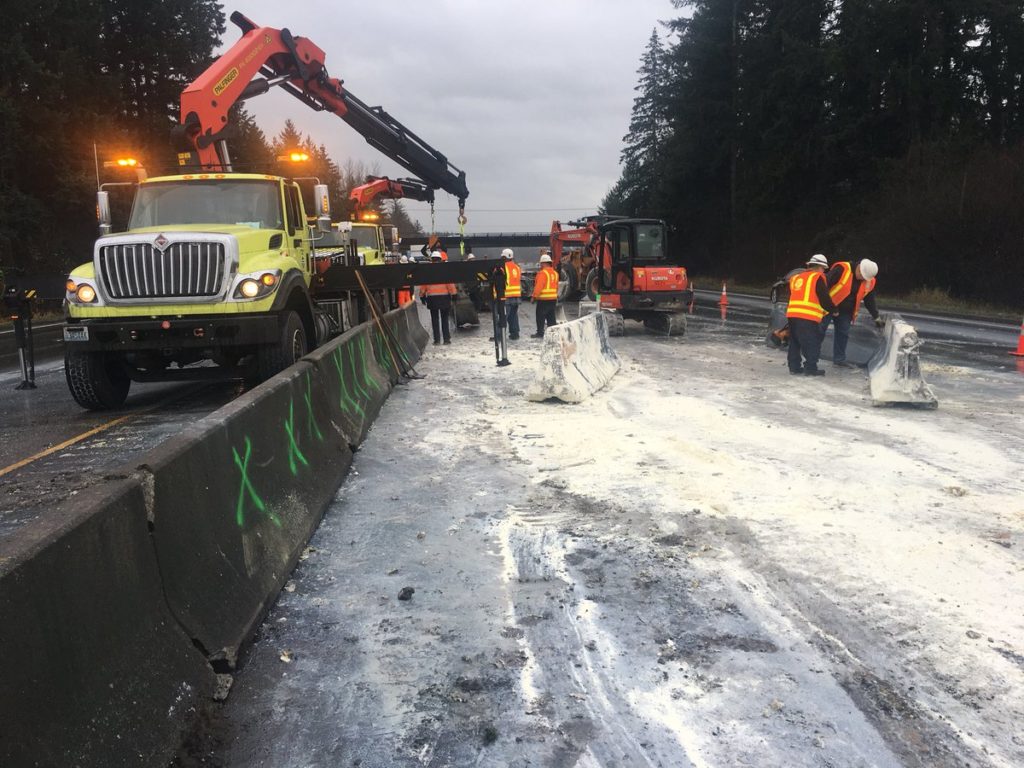Overview of I5 Crashes
Interstate 5 (I-5) runs through the heart of Washington State and is one of the region’s busiest and most critical highways. This section provides a statistical overview of crash incidents, highlighting the road’s reputation for heavy traffic and high accident rates.
Statistics of I-5 Crashes
Recent statistics underscore the hazardous nature of I-5:
- Fatal Crashes: According to a study by Geotab, I-5 has been identified as the most dangerous highway in Washington, with 245 fatal crashes resulting in 258 fatalities over the last decade.
- Crash Rate: The fatal crash rate on the Washington portion of I-5 is 0.3, ranking it the 40th most dangerous highway in the states analyzed in the study.
- Annual Traffic: The highway sees about 73 million vehicle movements annually, underscoring its status as a heavily trafficked route.
- Data Tracking: The Washington State Department of Transportation maintains a decade of detailed crash data, including specifics like accident locations and weather conditions at the time of incidents.
These statistics reveal that the challenges on I-5 are significant, with a high volume of traffic and dangerous driving conditions contributing to its reputation. Understanding these factors is crucial for addressing safety and reducing the number of accidents on this key interstate highway.
Why So Many Accidents Happen on Interstate 5(i-5)
Interstate 5 (I-5) is recognized as one of the most hazardous highways in the United States. Various factors converge to make it a hotbed for vehicular accidents, from its extensive traffic and challenging driving conditions to human behavioral issues.
Here are the primary reasons contributing to the frequent accidents on I-5:
Traffic Congestion
I-5 serves as a crucial artery along the West Coast, accommodating many vehicles daily, including a significant proportion of large commercial trucks. The road passes through major urban areas like Los Angeles and Seattle, where traffic congestion is particularly severe.
These congested conditions greatly increase the likelihood of collisions as vehicles are often nearby, reducing drivers’ reaction times to sudden stops or lane changes.
Speeding
Many sections of I-5 have long, flat stretches that tempt drivers to exceed speed limits, especially in less congested rural areas or during off-peak hours.
Excessive speeding is a predominant cause of accidents on I-5, as higher speeds reduce the effectiveness of safety mechanisms and increase the severity of crashes.
Inclement Weather
Parts of I-5, such as the notorious Grapevine area, are prone to sudden and severe weather changes, including heavy fog, rain, snow, and high winds.
These weather variations can dramatically decrease visibility and make the roadway slick, challenging even the most experienced drivers and increasing the risk of accidents.
Steep Terrain
The section of I-5 running through the Tejon Pass, known as the Grapevine, features a steep 6% grade descent over five miles. This demanding terrain is particularly hazardous for trucks that may struggle with brake maintenance, leading to brake failure and loss of vehicle control.
Truck Driver Fatigue
Long-haul trucking is common on I-5, and driver fatigue is a critical safety issue. Drivers exceeding the hours of service regulations may become drowsy, decreasing their attention and reaction time, which can lead to serious accidents involving large commercial vehicles.
Impaired and Distracted Driving
As with any major highway, I-5 sees its share of accidents caused by drivers impaired by alcohol or drugs. Additionally, the increasing use of mobile devices contributes to a rise in accidents due to distracted driving.
Impaired and distracted driving significantly impair drivers’ ability to react to changing traffic conditions and navigate safely.
These factors create a complex and often dangerous driving environment on I-5, underscoring the need for heightened awareness and caution from all who travel on this major interstate highway.
Results of I5 Crashes
The consequences of accidents on Interstate 5 (I-5) are far-reaching, impacting those directly involved and the broader community.
Economically, crashes on I-5 cause significant disruptions, leading to costly road closures, traffic congestion, and extensive delays that affect thousands of commuters and the transport of goods daily.
These delays can result in lost productivity and increased transportation costs, ultimately trickling down to consumers. In terms of human impact, accidents on I-5 frequently result in severe injuries and, tragically, fatalities, placing a heavy burden on emergency response systems and local healthcare facilities.
Hospitals and emergency services along the I-5 corridor are often stretched to their limits due to major accidents, dealing with the immediate needs of crash victims and managing the ongoing demand for medical services.
The psychological impact on the families and communities involved is profound and enduring, adding another layer of tragedy to the tangible consequences of these incidents.
How to Avoid Crashes on I-5?
Navigating Interstate 5 (I-5) safely requires attentiveness, adherence to traffic laws, and consideration of road conditions. Drivers can adopt preventive measures to minimize the risk of accidents on this extensive and often hazardous highway.
Here’s how to increase safety and avoid crashes on I-5:
#1 Be Alert and Avoid Distractions
Maintain focus and vigilance at all times while driving on I-5. Distractions such as mobile devices, eating, or adjusting in-car controls can significantly impair your ability to react to sudden changes or hazards on the road.
Keeping your eyes on the road and your hands on the wheel can prevent many accidents caused by inattention.
#2 Adjust for Weather Conditions
I-5 can experience a variety of severe weather conditions, especially in mountainous stretches like the Grapevine. Be prepared to face heavy rain, snow, fog, and high winds.
Reduce your speed, use headlights, and increase your following distance to ensure you have enough time to react to road conditions and traffic.
#3 Maintain Proper Following Distance
To avoid rear-end collisions, common in congested traffic conditions on I-5, ensure ample space between your vehicle and the one ahead. This allows adequate stopping distance should traffic suddenly halt or slow down.
#4 Be Cautious on Steep Grades
The steep grades, particularly through areas like the Grapevine, require careful navigation. Use lower gears to control your descent speed, and apply brakes gradually rather than continuously to prevent brake overheating and ensure you maintain control of your vehicle.
#5 Avoid Fatigued or Impaired Driving
Driving while drowsy or under the influence of alcohol or drugs can drastically reduce your reaction times and decision-making capabilities on I-5. Ensure you are well-rested and sober when driving, especially during long stretches or late hours.
#6 Check Blind Spots
Before changing lanes, especially on a multi-lane freeway like I-5, diligently check your blind spots. This practice is crucial to prevent sideswipe incidents and collisions during lane changes, frequent on busy highways.
#7 Obey Speed Limits
Adhering to speed limits is essential on I-5, where varying traffic flow and frequent law enforcement patrols occur. Speeding increases both the likelihood of crashes and their severity. Adjust your speed according to traffic, weather conditions, and posted signs to maintain safety.
By implementing these safety tips, drivers can significantly reduce their risk of accidents and ensure a safer journey along the bustling I-5 corridor.
Powdered Milk Truck Crash on I-5
For several hours yesterday, a rollover truck crash on I-5 resulted in the closure of all the southbound lanes, and part of the northbound lanes. The crash occurred between Tumwater and Maytown near 113th Avenue, but affected drivers from Portland to Seattle.
The Thurston County Sheriff reported that a second crash – a hit-and-run on I-5 northbound – also contributed to the traffic disaster.

Preliminary information from Washington State Patrol indicated that a passenger truck driver heading north on I-5 lost control of their vehicle. A state trooper said the passenger truck was travelling too fast for the wet conditions, and the driver lost control.
The vehicle started to spin out, and an approaching semi-truck swerved to avoid it.
The truck driver lost control of their tractor-trailer. The rig plowed through the center concrete barrier into southbound I-5, where it hit a FedEx truck.
The semi-truck overturned, spilling part of its cargo of bags of powdered milk.
Helpful Reading: Truck Accident Settlements and Verdicts

It took road crews several hours to clean up the roadway after the rollover truck crash.
First, they had to remove the destroyed semi-truck. The powdered milk and truck debris had to be removed with heavy equipment.
Then, they had to replace the damaged concrete barrier separating the north and southbound lanes of I-5.
One southbound lane was eventually opened to traffic several hours after the truck crash on I-5. All lanes were reopened around 4 p.m.
Recommended Article: Why is a Semi Truck Called a Semi Truck
Could the milk truck crash on I-5 have been avoided?
Based on the information we have so far, it sounds like the events were started by a driver who was speeding and lost control.
But commercial truck drivers learn defensive driving, and how to avoid collisions. In this instance, it appears that the semi-truck driver avoided a collision with the passenger vehicle, but in doing so, caused the tractor-trailer to turn over.
The concerning thing about the way this incident occurred is how the tractor-trailer crashed into oncoming traffic. Commercial truck drivers are trained to never swerve into oncoming traffic.
And, the driver should have known that a heavy trailer was at risk of rolling over at highway speeds. The truck driver’s failure to account for the trailer’s weight might have contributed to the rollover.

The speed of the semi-truck was likely an additional factor, as it appears to have been in the left or possibly center lane. Properly trained semi-truck drivers are taught to allow an appropriate “space cushion” for a situation that may occur, such as happened here.
They are also taught to make sure that have sufficient braking distance to avoid being involved in a crash. I have recently handled two similar cases wherein semi-truck drivers did not anticipate likely hazards and did not properly consider the weather conditions and how those conditions affected braking distances and crash avoidance.
It’s the season for winter weather crashes, and Washington is not off to a good start. State troopers reported multiple serious crashes so far, some with fatalities.
Helpful Reading: Things You Should Know About Tanker Truck Accidents





One Response
Is this writer related to the pickup truck driver? Sure seems so! He was the cause of this accident.